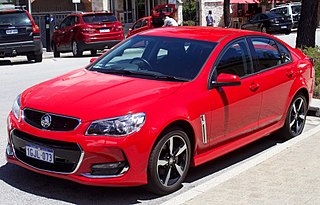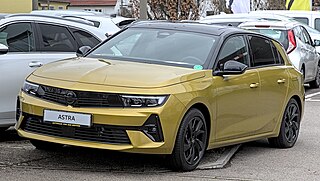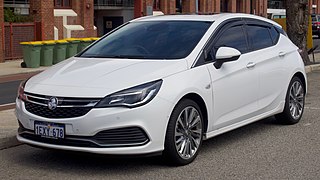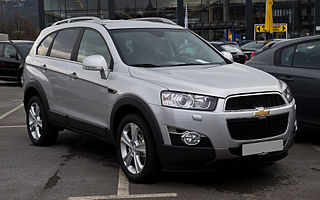
The Holden Commodore is a series of automobiles that were sold by former Australian manufacturer Holden from 1978 to 2020. They were manufactured from 1978 to 2017 in Australia and from 1979 to 1990 in New Zealand, with production of the locally manufactured versions in Australia ending on 20 October 2017.

The Opel Astra is a compact car/small family car (C-segment) developed and produced by the German automaker Opel since 1991, currently at its sixth generation. It was first launched in September 1991 as a direct replacement to the Opel Kadett. As of 2021, the car slots between the smaller Corsa supermini and the larger Insignia large family car.

The Holden Astra is a small car formerly marketed by Holden. The first couple of generations of Astra were made only for Australia, and was a derivative of the locally produced Nissan Pulsar. With the Button car plan coming into effect, it was replaced by the Holden Nova, a rebadged Toyota Corolla.

The Opel Vectra is a mid-size car that was engineered and produced by the German automaker Opel from 1988 until 2010. Available in saloon, hatchback and estate body styles, the Vectra was also sold by the Vauxhall marque in the United Kingdom as the Vauxhall Cavalier from 1988 to 1995 and then as the Vauxhall Vectra from 1995 to 2008, and it was also sold by Holden in Australia as the Holden Vectra, by Chevrolet in Latin America as the Chevrolet Vectra.

The Opel Omega is an executive car engineered and manufactured by German automaker Opel between 1986 and 2004. The first generation, the Omega A (1986–1994), superseded the Opel Rekord. It was voted European Car of the Year for 1987, and was available as a saloon or estate. The second generation, the Omega B, was manufactured from 1994 to 2004.

Holden Special Vehicles (HSV) was the officially designated performance vehicle division for Holden. Established in 1987 and based in Clayton, Victoria, the privately owned company modified Holden models such as the standard wheelbase Commodore, long wheelbase Caprice and Statesman, and commercial Ute for domestic and export sale. HSV also modified other non-Holden cars within the General Motors lineup in low volumes.

The Buick Regal is a line of mid-size cars marketed by Buick since 1973. For nearly its entire production, the Regal has served as the premium mid-size/intermediate offering of the Buick product range. Introduced as a submodel of the Buick Century, the model line is currently in its sixth generation. From the 1970s to the 1990s, the Regal served as the Buick counterpart of the Pontiac Grand Prix and Oldsmobile Cutlass Supreme.

Epsilon is General Motors' mid-size front-wheel drive automobile platform. The architecture was a multi-division project of GM North America, Opel and Saab, and debuted in the 2002 Opel Vectra and 2003 Saab 9-3. Since this platform falls squarely in the center of the worldwide automobile market, GM plans to produce a great many Epsilon vehicles with over a dozen variations. As of 2005, it was GM's highest volume worldwide platform. Even after the dissolution of the GM/Fiat partnership, both companies retain the rights to continue developing Epsilon-derived models.

The Chevrolet Captiva is a compact crossover SUV marketed by General Motors. The first generation was developed by GM Korea, based on the GM Theta platform and derived from the S3X concept car revealed in 2004. Released in 2006, it was sold internationally as Chevrolet Captiva, in Australia and New Zealand as Holden Captiva and in South Korea as Daewoo Winstorm until 2011, when the international name was adopted. The vehicle shares much its underpinnings with the similarly-styled Opel/Vauxhall Antara / second-generation Saturn Vue, with the Captiva offering optional third-row seating.

VXR was the branding for the high performance trim specification, used since 2004 for models in many of Vauxhall's car range in the United Kingdom. Holden has also used the VXR badge for some of its high-performance cars such as the Astra VXR, Insignia VXR, and the Commodore VXR.

The Opel Antara is a compact crossover SUV which was marketed by Opel from 2006 to 2015. Based on the Theta platform, the Antara closely shared its underpinnings and powertrains with the Chevrolet Captiva. Unlike the Captiva, it is only offered with five seats instead of seven, and features a different exterior and interior design. Sales commenced in November 2006, as the indirect successor to the Isuzu-based Frontera range.

Opel Performance Center (OPC) was a division of the German automobile manufacturer Opel, initially set up as a subsidiary in 1997. The main focus of OPC is the development of performance derivatives of the Opel range, such as the hot hatch Corsa OPC and Astra OPC.

The Holden Commodore (VZ) is a full-size car that was produced by Holden from 2004 to 2006 as a sedan and to 2007 as a wagon and Ute sold alongside the new VE series. It was the fourth and final iteration of the third generation of the Commodore and the last to spawn a coupé variant. Its range continued to include the luxury variants, Holden Berlina (VZ) and Holden Calais (VZ).

The Holden Commodore (VE) is a full-size car that was produced from 2006 to 2013 by Holden—the Australian subsidiary of General Motors. Dubbed Holden's "billion dollar baby", the car was available as the Holden Berlina—the mid-range model—and the Holden Calais, the luxury variant; utility body styles were marketed as the Holden Ute.

The Holden Commodore (VY) is a full-size car that was produced by Holden from 2002 to 2004. It was the third iteration of the third generation of the Commodore. Its range included the luxury variants, Holden Berlina (VY) and Holden Calais (VY); commercial versions were called the Holden One Tonner (VY), Holden Ute (VY), and Holden Crewman (VY). In 2003, the range also saw the introduction of the first Commodore-based all-wheel drive variants, including the Holden Adventra (VY) wagon.

The WM and WN series are the third and final generation of the Holden Caprice/Statesman, a range of full-size luxury saloons produced by the Australian manufacturer Holden from August 2006 to October 2017, sold primarily in Australia and New Zealand. They were also exported in various guises to the United States, the Middle East, China and South Korea. The range debuted alongside the smaller VE series Holden Commodore, which the Caprice shares its "Zeta" platform with, on 16 July 2006 at the Melbourne Convention and Exhibition Centre.
General Motors New Zealand Limited, formerly Holden New Zealand Limited, is a subsidiary of General Motors that distributes GM' motor vehicles, engines, components and parts in New Zealand.

The Ford Freestyle is a crossover utility vehicle that was sold by Ford from 2005 to 2009. Largely marketed as the successor to the Ford Taurus station wagon, the Freestyle was the CUV counterpart of the Ford Five Hundred and Mercury Montego four-door sedans. Sharing the Ford D3 platform with the Five Hundred and Montego, the Freestyle was produced with both front-wheel drive and all-wheel drive configurations and six- or seven-passenger seating.

The Opel Insignia is a large family car developed and produced by the German car manufacturer Opel from 2008 to 2022. Taking its name from a 2003 concept car, the model line serves as the flagship model, slotted above the Astra and Corsa in size. The Insignia serves as the successor to both the Signum and Vectra model lines, replacing both vehicles under a single nameplate. Currently in its second generation, the model line is offered in four-door sedan/saloon body styles, five-door liftback, and as a five-door station wagon/estate.

The Holden Commodore (VF) is a full-size car that was produced by Holden between June 2013 and October 2017. It was the second and last significantly restyled iteration of the fourth (and final) generation of the Holden Commodore to be manufactured in Australia. Its range included the sedan and station wagon variants that sold under the luxury Holden Calais (VF) nameplate. Also available was the commercial utility variant that sold under the Holden Ute (VF) nameplate.

























